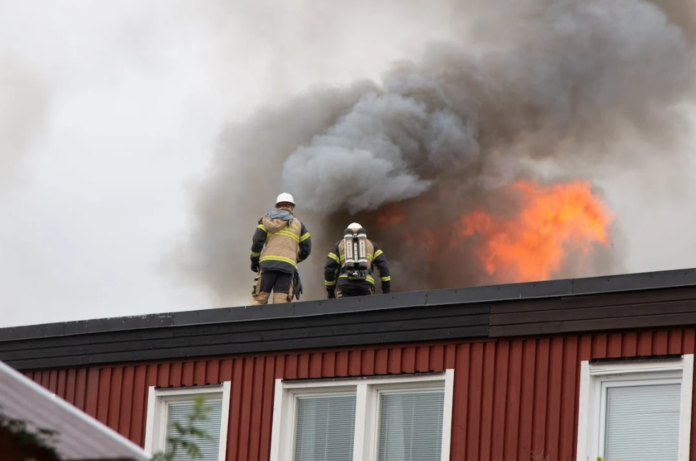It’d be hard to imagine yourself trapped inside a building consumed by flames, with smoke billowing around you. However, this could become a reality, given the growing number of fire incidents across the United States.
It’s a nightmare situation no one wants to experience, but being prepared can make all the difference between life and death. Your knowledge and actions can be your greatest allies when faced with such a terrifying ordeal.
In this blog post, we’ll guide you through essential steps to ensure your safe escape from a building engulfed in flames.
Stay Calm in Crisis
When confronted with a life-or-death situation like escaping from a building consumed by flames, keeping a level head is paramount. When you panic, you can barely see things in perspective, which hinders your chances of survival.
However, studies have found that many people panic during fire incidents due to several reasons. Firstly, a lack of understanding about the situation can result in heightened panic. Secondly, the degree of panic tends to intensify as individuals perceive the fire to be more severe.
To maintain composure, your actions hold the greatest significance. Focus on what needs to be done, and trust in your ability to make it through.
Now, let’s go through a few effective ways to help you maintain composure when it matters most.
- Breathe deeply: Deep breaths help oxygenate your brain and body, keeping your mind clear and your muscles functional in the face of danger.
- Think rationally: Avoid emotional reactions. Assess the situation calmly, identify exits, and prioritize your escape plan.
- Communicate clearly: If you are with others, communicate your intentions clearly. This action will help ensure that everyone remains on the same page during the escape.
- Use positive self-talk: Remind yourself that staying calm increases your chances of survival. Repeating affirmations can help boost your confidence.
- Practice mindfulness: Stay in the moment, focusing on each step of your escape plan. This can help reduce anxiety and keep you grounded.
Check for Fire Extinguishers
During a fire emergency, every second counts. At times, a small fire can be managed if you act swiftly and safely. Start by scanning your surroundings for fire extinguishers, often found in easily accessible locations like hallways, kitchens, or near exit doors. When you spot one, assess the fire’s size and your ability to use the extinguisher.
However, choosing the right fire extinguisher is as important as having one on hand. During a home fire, it’s best to use dry powder fire extinguishers. Be sure to avoid using aqueous film-forming foam (AFFF firefighting foam). According to TorHoerman Law, the use of AFFF firefighting foam has been linked to health conditions, including cancer, birth defects, etc.
In fact, in previous incidents where individuals used this foam, they have developed the mentioned health conditions. This has led them to take legal action by filing an AFFF foam lawsuit. The lawsuits aim to recover compensation for the losses and suffering victims have endured. By taking legal action, victims also aim to raise awareness to prevent similar incidents in the future.
Alert Others and Emergency Services
During a fire, timely communication can be a crucial lifeline. Once you’ve detected a fire and begun your escape, it’s vital to alert others in the building. Shout “Fire!” loudly to warn anyone who may not be aware of the danger.
Knock on doors as you pass to ensure your neighbors are informed. If you encounter someone in distress, assist them if it’s safe to do so. While your focus should be on your own escape, every action you take to alert others can make a significant difference.
Simultaneously, call 911 or the local emergency services number as soon as possible. Share your location, describe the emergency, and provide any relevant information about the fire, such as its position or magnitude. Promptly notifying emergency services is critical for a faster response, preventing the fire from spreading or causing more harm.
Create an Emergency Plan
In today’s fast-paced world, where every second counts in a fire emergency, having a well-thought-out emergency plan can be a lifesaver. The National Fire Protection Association (NFPA) shares important insights about the timing of escapes during a fire incident. According to NFPA, escaping a home fire now takes only two minutes after the smoke alarm sounds, down from over 10 minutes.
This emphasizes the urgent need for a well-prepared emergency plan. Begin by gathering your household and discussing escape routes and meeting points. Assign roles to each member to ensure a smooth evacuation. Consider the unique needs of vulnerable family members like women, the elderly, or young children.
Make sure everyone knows how to operate windows and doors. If you live in a multi-story building, familiarize yourself with the stairwells as a secondary escape option. Creating an emergency plan is also about being prepared to act quickly and decisively when seconds matter most.
Locate the Escape Routes
When fire strikes, knowing how to get out of the building quickly can be a matter of life and death. Stay low to the ground to avoid smoke and toxic fumes. Let’s break down five easy and effective steps to help you locate escape routes effectively:
- Follow emergency signs: Look for emergency evacuation maps, which are often posted in public buildings to guide you to safety.
- Know alternative exits: Be aware of all possible exits, including windows, stairwells, and any doors that lead outside.
- Practice drills: Familiarize yourself with escape routes during non-emergency situations. Regular drills can help you react quickly in a real crisis.
The increasing incidents of fire have made American citizens aware of the importance of having escape routes in their homes. According to Hartford’s 2023 Home Fire Index, there has been a 16% increase in the number of U.S. residents who have now established a fire escape plan. Having an escape plan in place can greatly enhance your chances of safely exiting a building.
In Conclusion
In the face of a building consumed by flames, your actions can be the difference between survival and tragedy. The key to a safe escape lies in preparedness, remaining calm, and knowing what to do. This blog has discussed critical steps that can help you safely escape from a dangerous situation.
With a clear head, you can navigate the chaos of a fire emergency and protect yourself and your loved ones. Being proactive and practicing these safety measures can mean the world when seconds count.


























